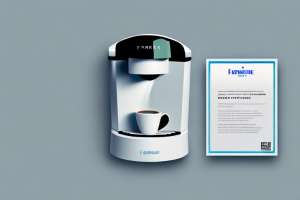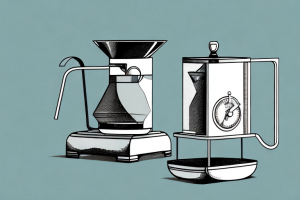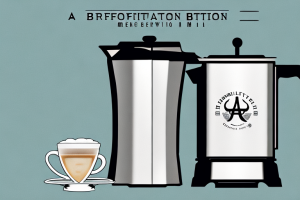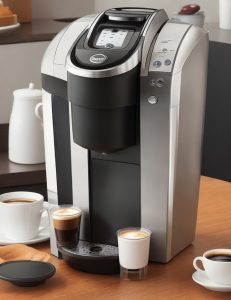Troubleshooting A Cuisinart Coffee Maker

A cuisinart coffee maker with a few tools and components laid out around it
Are you facing issues with your Cuisinart coffee maker? Don’t worry, troubleshooting your coffee maker can be done easily. In this article, we will guide you through the various components, common problems, and how to diagnose and solve issues with your coffee maker. So let’s dive in!
Understanding the Components of a Cuisinart Coffee Maker
Before diving into the troubleshooting process, let’s first understand the different components of a Cuisinart coffee maker. It comprises a water reservoir, a heating element, a filter basket, and a carafe. These components work together to ensure that you enjoy a perfect cup of coffee every time you brew.
The water reservoir is where you pour in the water that will be used to brew your coffee. It is usually located at the back of the coffee maker and has a maximum fill line to prevent overfilling. The heating element is responsible for heating the water to the optimal temperature for brewing coffee. It is located beneath the water reservoir and is controlled by the coffee maker’s circuitry.
The filter basket is where you place the coffee grounds. It is usually located at the top of the coffee maker and can be removed for easy cleaning. The carafe is where the brewed coffee is collected. It is usually made of glass or stainless steel and has a handle for easy pouring. Some Cuisinart coffee makers also come with a thermal carafe that keeps the coffee hot for a longer period of time.
Common Problems Faced by Cuisinart Coffee Maker Users
Some users have faced issues like leaking, incomplete brewing, incorrect temperature, and fault in programming, to name a few. But, before troubleshooting, it’s crucial to understand the root cause of the problem.
One of the most common problems faced by Cuisinart coffee maker users is the accumulation of mineral deposits in the machine. This can lead to clogging and affect the taste of the coffee. To avoid this, it’s recommended to descale the coffee maker regularly using a mixture of water and vinegar.
Another issue that some users have reported is the coffee maker not turning on or shutting off unexpectedly. This could be due to a faulty power cord or a malfunctioning heating element. In such cases, it’s best to contact the manufacturer for assistance or get the machine repaired by a professional.
Diagnosing Issues with Your Cuisinart Coffee Maker
If your coffee maker is causing trouble, you must first diagnose the issue. If your coffee maker has low brewing speed, then it might be due to the improper functioning of the heating element, clogged filter or coffee grounds, or inadequate water levels.
To diagnose further, be ready to disassemble the components and check the water flow and the filter thoroughly. If you have a programmable coffee maker, make sure the settings are correct and add the correct amount of coffee grounds for the water used. If your coffee maker is not performing as fast as you want, consider descaling or deep cleaning it.
Another common issue with coffee makers is when the coffee tastes bad or has an unusual flavor. This can be caused by using old or stale coffee grounds, using too much or too little coffee, or using low-quality water. To fix this issue, make sure to use fresh coffee grounds, measure the correct amount of coffee, and use filtered or bottled water. Additionally, regularly cleaning your coffee maker can help prevent buildup of oils and residue that can affect the taste of your coffee.
How to Fix a Leaking Cuisinart Coffee Maker
A leaking coffee maker can be caused by several issues. Firstly, check that the water reservoir or the carafe is firmly seated. If this is not the problem, then the gaskets inside the brew head might be worn out and need replacement. In some cases, the valves could be clogged and need descaling or cleaning. The hotplate could also be the cause of the leaking and might need a replacement.
Another possible cause of a leaking Cuisinart coffee maker is a cracked or damaged water tank. If you notice any cracks or damage, it is best to replace the water tank to prevent further leaks. Additionally, if you have been using the coffee maker for a long time, the hoses and tubes inside the machine could be worn out and need replacement.
To prevent future leaks, it is important to regularly clean and maintain your Cuisinart coffee maker. This includes descaling the machine every few months to remove any mineral buildup that could clog the valves and cause leaks. It is also important to regularly clean the brew head and hotplate to prevent any buildup that could cause leaks or affect the taste of your coffee.
Solving Issues with the Brewing Process of Your Cuisinart Coffee Maker
Issues involved with the brewing process of your coffee maker can be daunting. It could be the temperature, brewing strength, or incomplete brewing. To fix such issues, check the water levels, cleaning, and descaling. If this doesn’t help, consider descaling it again or switching up your coffee beans and grinds for a better taste. It might also be a good idea to use filtered water to avoid contaminating your coffee maker.
Another common issue with coffee makers is the buildup of mineral deposits, which can affect the taste of your coffee. To prevent this, it’s important to regularly descale your coffee maker. You can use a descaling solution or a mixture of vinegar and water to remove any buildup. It’s recommended to descale your coffee maker every 3-6 months, depending on how often you use it.
If you’re still experiencing issues with your coffee maker, it might be time to replace some of the parts. The filter, for example, can become clogged over time and affect the brewing process. Make sure to replace the filter regularly to ensure the best possible taste. Additionally, if your coffee maker has a thermal carafe, it’s important to check the seal to make sure it’s not leaking. A faulty seal can cause the coffee to lose heat and affect the taste.
Tips for Cleaning Your Cuisinart Coffee Maker Properly
Maintenance is a crucial aspect that coffee maker users often forget. Be sure to read the manual thoroughly for specific instructions. Cleaning your Cuisinart coffee maker properly and regularly can extend its lifespan and add consistency to the taste of your coffee. You can use vinegar and hot water or a coffee maker cleaning solution to clean your coffee maker thoroughly.
One important thing to keep in mind when cleaning your Cuisinart coffee maker is to always unplug it before starting the cleaning process. This will ensure your safety and prevent any electrical accidents from occurring. Additionally, it is recommended to clean the coffee maker after every use to prevent any buildup of coffee oils and residue that can affect the taste of your coffee.
Another useful tip is to clean the carafe separately from the coffee maker. This will ensure that the carafe is thoroughly cleaned and prevent any leftover residue from affecting the taste of your coffee. You can use a mixture of hot water and dish soap to clean the carafe, and rinse it thoroughly before using it again.
Replacing Parts on Your Cuisinart Coffee Maker: A Step-by-Step Guide
The parts of your Cuisinart coffee maker can wear out over time, but replacing them can help it function as good as new. The manual’s instructions are highly recommended for safe replacement. It’s best to use original Cuisinart parts to ensure durability.
Before replacing any parts on your Cuisinart coffee maker, make sure to unplug it and let it cool down completely. This will prevent any accidents or injuries while handling the machine. Additionally, it’s important to regularly clean your coffee maker to prevent any build-up or damage to the parts. A simple cleaning with vinegar and water can go a long way in extending the life of your machine.
How to Program Your Cuisinart Coffee Maker for Optimal Performance
Programming your Cuisinart coffee maker for the perfect brewing is highly recommended. To program your coffee maker, check for the correct time and date, use fresh coffee grounds, and make sure water and ground coffee levels are proportionately good. You can refer to your manual on programming coffee makers to understand the process better.
Additionally, it is important to clean your coffee maker regularly to maintain optimal performance. This can be done by running a mixture of water and vinegar through the machine, followed by a few cycles of plain water. It is also recommended to descale your coffee maker every few months to remove any mineral buildup that may affect the taste of your coffee. By following these simple steps, you can ensure that your Cuisinart coffee maker continues to brew delicious coffee every time.
Troubleshooting Specific Models of Cuisinart Coffee Makers
Cuisinart has various models of coffee makers, and different issues can arise in different models. These problems can be solved using the instructions provided in the user manual. In case the issue cannot be fixed, contacting customer service or a certified Cuisinart repair center is highly recommended.
One common issue that can occur in Cuisinart coffee makers is a clogged filter. This can cause the coffee maker to overflow or produce weak coffee. To fix this issue, remove the filter and clean it thoroughly. If the problem persists, try using a different type of coffee filter or contacting customer service for further assistance.
Another issue that can arise in certain models of Cuisinart coffee makers is a malfunctioning heating element. This can cause the coffee maker to not heat up properly or produce lukewarm coffee. If this is the case, it is recommended to contact a certified Cuisinart repair center for assistance, as attempting to fix the heating element yourself can be dangerous.
Conclusion
Finally, we hope this guide has covered all the aspects of troubleshooting the Cuisinart coffee maker. Careful diagnosis, maintenance, and replacements are all crucial to ensure long-lasting performance and consistency in brewing your coffee. Follow the instructions provided to enjoy a perfect cup of coffee every time.
It is important to note that regular cleaning of the coffee maker is also essential to maintain its performance. Make sure to clean the carafe, filter basket, and water reservoir after every use. Additionally, descaling the machine every few months will help remove any mineral buildup that can affect the taste of your coffee. By following these simple steps, you can ensure that your Cuisinart coffee maker stays in top condition and continues to brew delicious coffee for years to come.



